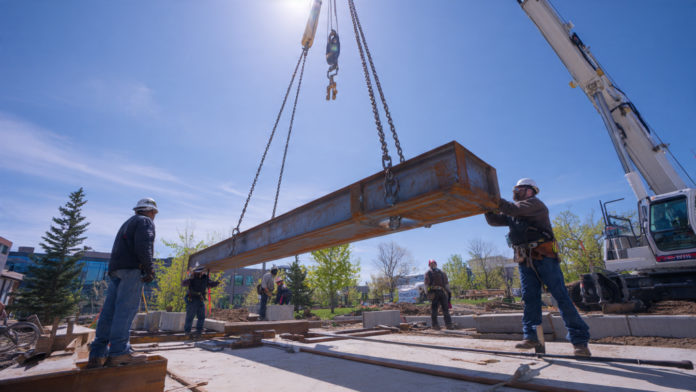When you’re lifting large, awkward objects—such as steel beams, LVLs, hot tubs, or oversized windows—using the proper rigging tools not only ensures safety but also prevents you from losing sleep, delaying the schedule, or damaging costly materials.
Here’s a homeowner- and contractor-friendly overview of essential rigging tools that deliver reliable results with less stress during any serious renovation or construction project.
Begin with the right mindset: plan, don’t improvise.
“Rigging gear” refers to the hardware that connects your load (beam, stair, window) to whatever is lifting it—crane, hoist, forklift, etc. Think slings, shackles, hooks, and below-the-hook devices like spreader bars.
Regulators require that rigging equipment be inspected before each use and clearly marked with its working load limit (WLL). This isn’t just a legal requirement; it’s one of the simplest ways to reduce stress on a jobsite. When every piece of gear is labeled, inspected, and documented, you prevent the panic of wondering “can this actually hold it?” during a critical lift.
1. Slings: The Backbone of Most Lifts
If you remember only one category of tools, it should be rigging slings. These flexible connectors wrap around or attach to the load and connect to hooks, shackles, or lifting beams. Common types include:
- Synthetic web slings
- Ideal for finished surfaces: cabinetry, pre-finished beams, glass packs, or painted metal.
- They’re light, easy to handle, and less likely to scratch or crush.
- Stress saver: color-coding and printed WLL markings make it easy to grab the right capacity quickly.
- Wire rope slings
- Ideal for rougher work: structural steel, precast concrete, or heavy framing.
- More abrasion- and heat-resistant than synthetics.
- Stress saver: incredibly durable when used within its rating and inspected regularly.
- Chain slings
- Best when you’re dealing with high temperatures, sharp corners, or very heavy, rugged loads.
- Often used by steel erectors and industrial riggers.
- Stress saver: adjustable chain legs help you accommodate different pick points without swapping out gear.
For any sling, load angle, and hitch type (vertical, choker, basket), capacity is dramatically affected, so pros will always refer to manufacturer charts and safety standards.
2. Shackles & Hooks: Small Parts, Huge Responsibility
Shackles and hooks are the unsung heroes that connect slings to lifting points and hardware. They look simple, but they carry enormous responsibility.
- Shackles
- D-shackles and bow shackles are used to link slings, chains, and lifting points.
- Should be clearly marked with WLL and manufacturer ID.
- Stress saver: a well-stocked set of properly sized shackles means no “sketchy” improvised connections.
- Hooks
- Found on hoists, cranes, and some slings.
- Modern rigging hooks often include safety latches (keepers) to prevent accidental unhooking.
- Stress saver: using the right hook with a functioning latch drastically reduces the risk of dropped loads.
Think of shackles and hooks as the “carabiners” of the rigging world—no one wants to find out during a lift that they were the weak link.
3. Hoists, Come-Alongs & Winches: Controlled Muscle
For many residential and small commercial projects, you don’t need to constantly bring in a large crane. That’s where manual and powered hoists excel.
- Chain hoists & lever hoists (come-alongs)
- Perfect for inch-by-inch control when setting beams, stair flights, or heavy built-ins.
- Stress saver: they let you creep a load into the perfect position instead of swinging it and hoping.
- Beam clamps & trolleys
- Beam clamps provide a secure anchor point on an I-beam.
- Trolleys roll along the beam, allowing you to shift loads horizontally.
- Stress saver: instead of man-handling a 600-lb component across a room, you roll it smoothly into place.
Combined with the right slings and shackles, these tools provide precise control and reduce the need for “white-knuckle” lifting.
4. Spreader Bars & Lifting Beams: Taming Awkward Loads
If you’re installing expansive windows, long beams, preassembled roof sections, or large panels, you’ll quickly discover that vertical lifting alone can cause twisting or crushing of the load. That’s where spreader bars and lifting beams come into play.
- Spreader bars
- Use top rigging and two or more bottom pick points to “spread” the slings apart.
- Ideal for broad or flexible loads that require compression control and keeping things upright.
- Lifting beams
- Support the load from multiple lower points with a central top connection to the crane or hoist.
- Great when headroom is limited or you need multiple balanced pick points.
Stress saver: these devices stabilize awkward loads and help prevent damage, rework, or mid-air surprises.
5. Eyebolts, Hoist Rings & Rigging Blocks: Making Lifts Repeatable
On projects where heavy components will be moved multiple times—such as modular stair flights, prefab wall panels, or rooftop units—installing dedicated lifting points can make each future lift easier.
- Eyebolts & hoist rings
- Thread directly into the load or a welded lifting lug.
- Swivel hoist rings can align with the sling angle, reducing side-loading and stress.
- Rigging blocks (sheaves/pulleys)
- Redirect lines or multiply pulling force in hoisting setups.
- Often used in tight spaces or tricky angles where a straight vertical lift isn’t possible.
Stress saver: once proper lift points are in place and labeled, each lift becomes more consistent, quicker, and less stressful.
6. Why Standards & Inspection = Less Stress
A large part of “less stress” is understanding that you’re operating within the limits of your equipment. Industry standards for slings, hardware, and lift planning all emphasize rated capacities, markings, and inspection requirements.
For you, that translates into practical habits:
- Buy gear that’s clearly labeled and from reputable manufacturers.
- Keep a simple inspection routine: check for cuts, kinks, deformation, corrosion, or missing labels before every lift.
- Remove questionable gear from service—don’t argue with your gut.
When the equipment is correct and the paperwork is complete, everyone on site relaxes a bit because the risks are being managed, not guessed at.
7. When to Bring in a Pro Rigger
Finally, the greatest stress-reliever of all: knowing when to call in specialists.
If you’re lifting:
- Anything over a few hundred pounds near people, property, or utilities
- Awkward or irreplaceable elements like custom glass, complex steel, or historic components
- In tight urban spaces or over neighboring structures
…you’re in “hire a professional rigging crew” territory. They’ll bring not only the tools above but also the calculations, lift plans, and experience to use them safely.
Essential rigging tools—slings, shackles, hooks, hoists, beam clamps, spreader bars, lifting beams, and dedicated lifting points—don’t just move heavy loads. They ensure your project remains calm, predictable, and on schedule when handling large weights.
Whether you’re a homeowner planning a major renovation or a contractor managing multiple trades, understanding these basics helps you ask better questions, identify warning signs, and collaborate with rigging professionals who lift safely—and with less stress.















